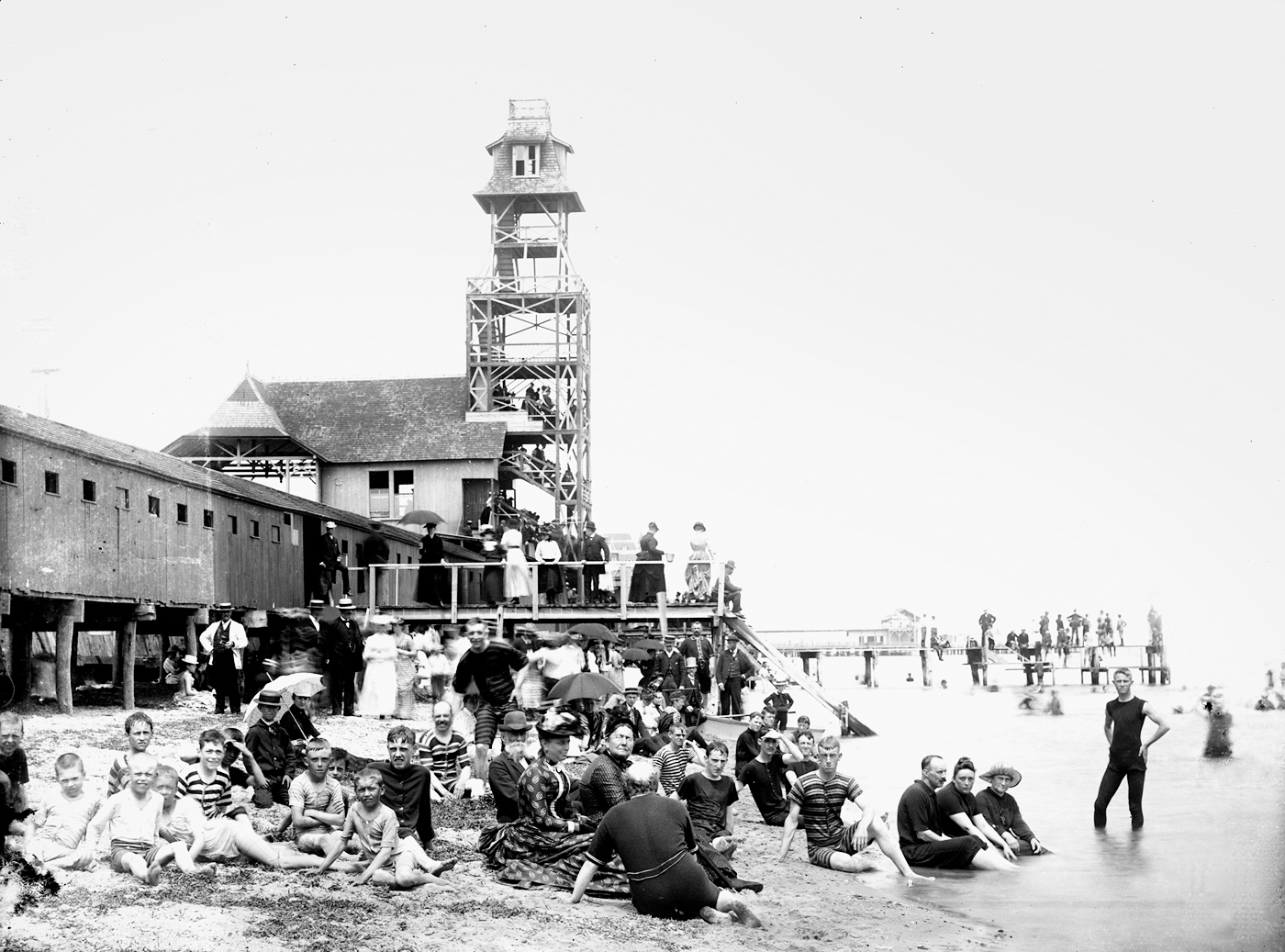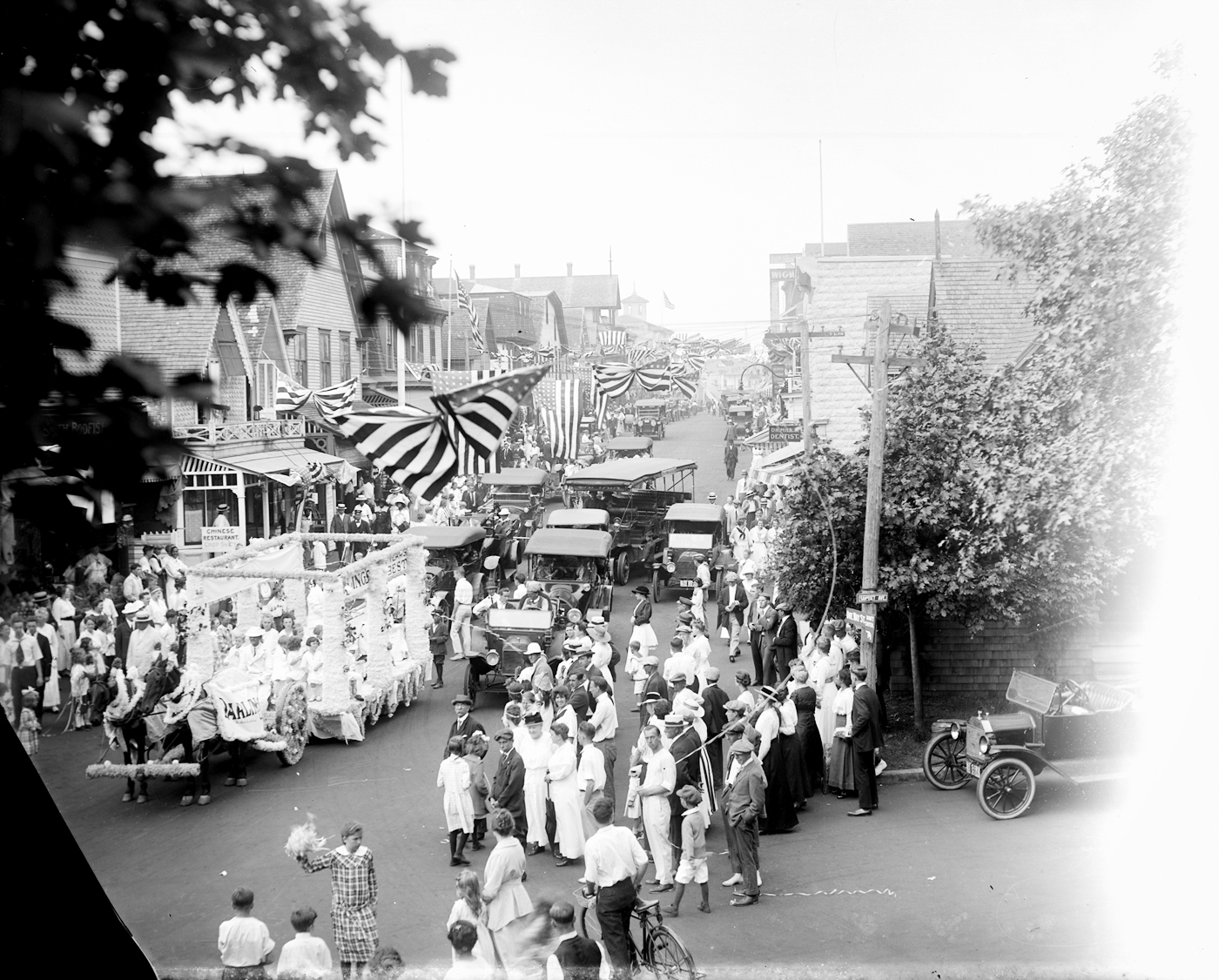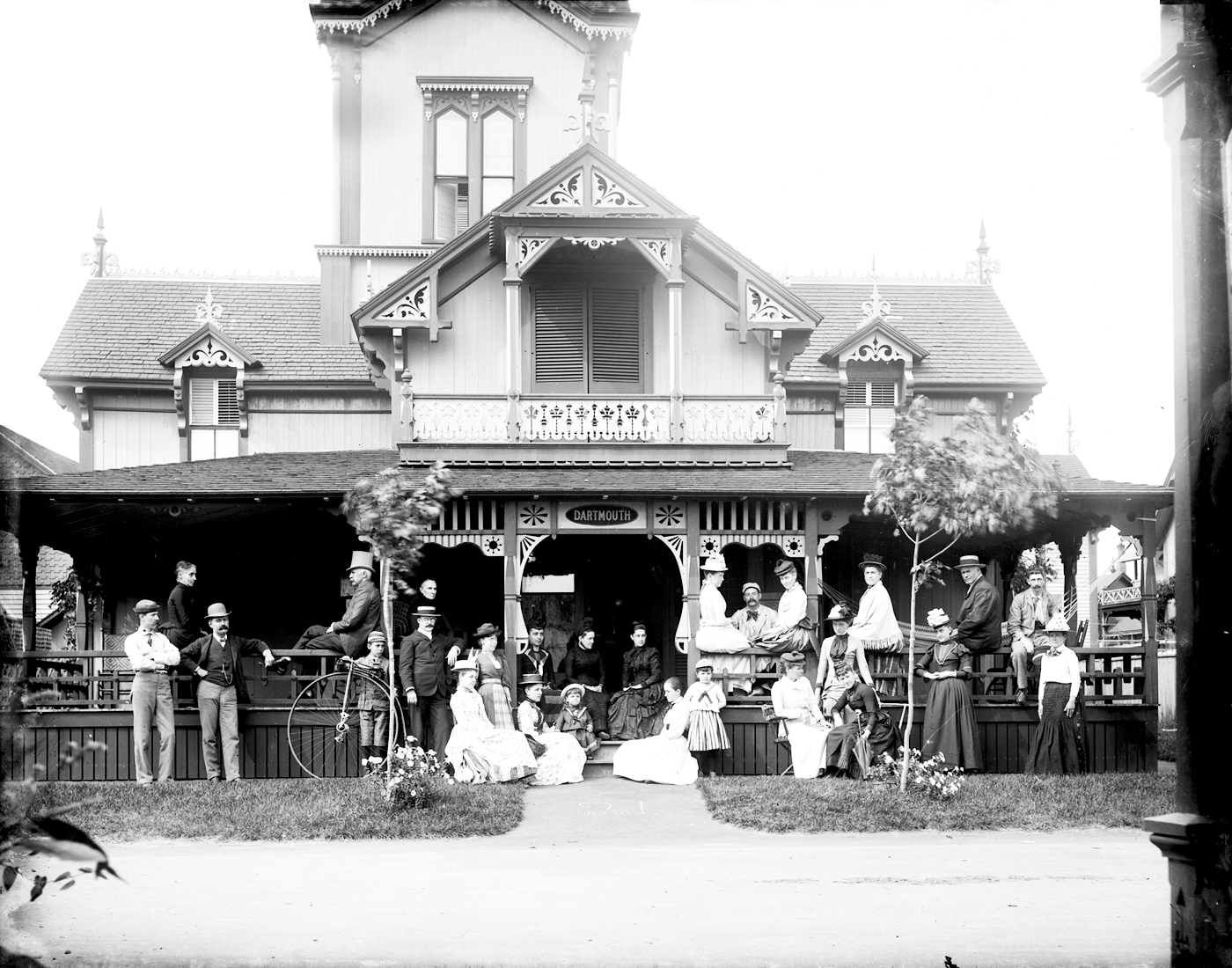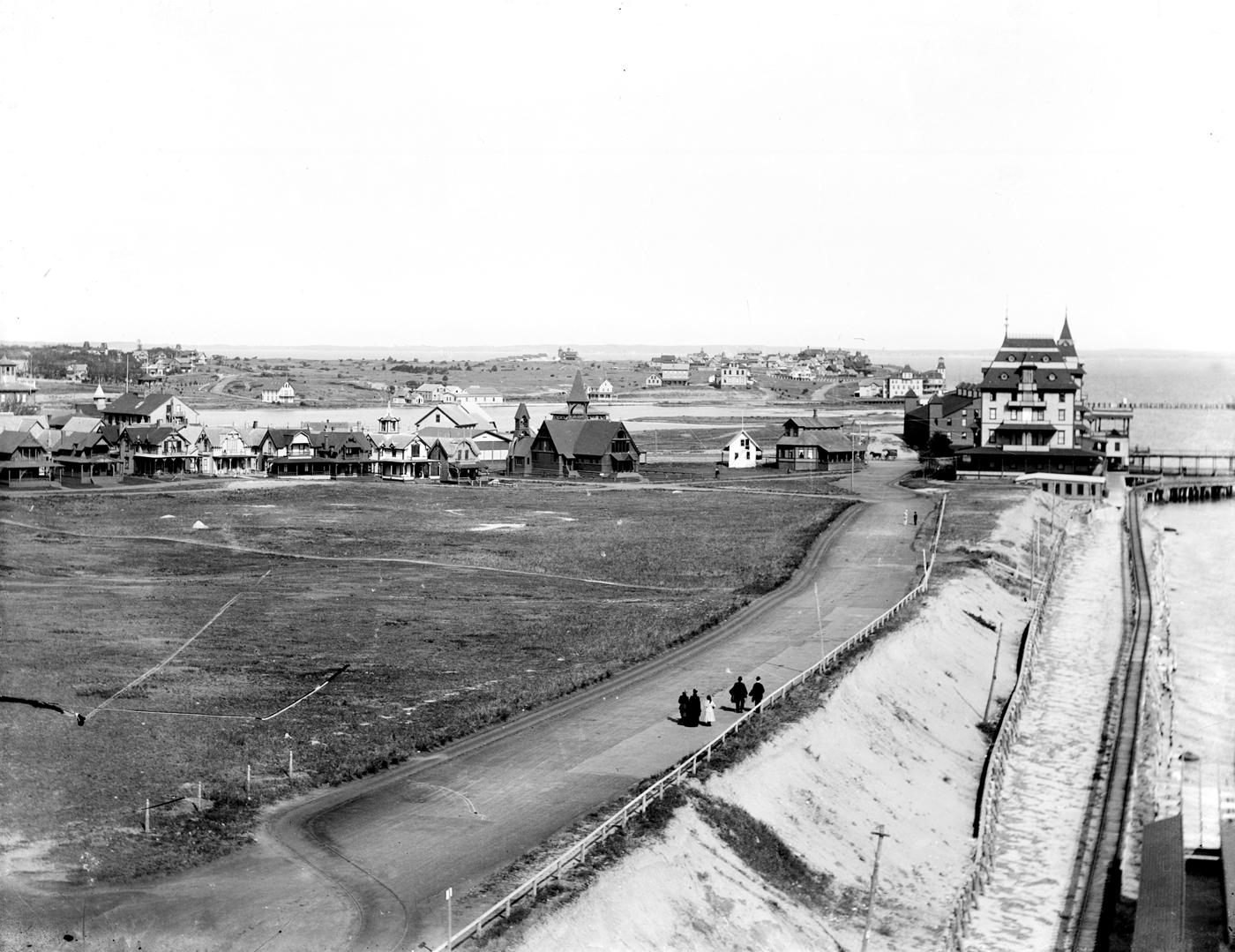In the history of the hawkers, hucksters and visionaries who knew how to turn a buck off of the middle-class mania for leisure and travel that emerged at the tail end of the American 19th century, Joseph Chamberlain has a firm, if overlooked place.
With a studio and home on Circuit avenue and a branch store near the Oak Bluffs wharf to cater to last-minute purchasers, Chamberlain was well positioned to market to the tourists hordes images of itself engaged in enjoying the oceanside playground that had been meticulously sculpted for its enjoyment.
Today, Chamberlain’s crisp, rich photographs reveal a host of long-lost relics in a familiar landscape. There is the entrancing sounding “Lovers’ Rock,” now buried under a jetty on the modern waterfront, an 850-foot toboggan run that was installed next to the Flying Horses in 1887 and operated for only a single summer season, and the 75-foot observatory tower that once afforded visitors a panoramic view of boardwalk, cottage city, and Vineyard Sound. There is the narrow gauge railroad that once ran along the shoreline between Oak Bluffs and Edgartown, and onward towards Katama.
There are long-gone Circuit avenue shops like “Kreekorian, Nahig and Co., Native Importers and Dealers in Oriental Goods,” and a host of more familiar yet ever-charming obsoletes like the horse and buggy, the steam-powered ferry and yes, those funny bicycles with the oversized front wheel.
In an exhibit opening this Friday at the Martha’s Vineyard Museum, a rare collection of unsigned glass plate negatives that improbably survived decades of obscurity in various garages and basements, and which have been attributed to Chamberlain by the museum’s staff, will be presented once again in all their glory.
The more than seventy glass plate negatives of Chamberlain’s work were donated to the museum by Alison Shaw, into whose hands they ultimately fell after a series of fortunate discoveries. In culling this number down into the fifteen that form the exhibition, Keith Gorman, the executive director of the Martha’s Vineyard Museum and the curator of this exhibit, chose images which play up the importance of the photos in the history of recreation and leisure, as well as in the history of photography.
In the beach scenes, Mr. Gorman points out, “You see people in these pretty elaborate woolen bathing suits,” with fully dressed bystanders looking on bemused. This fad of sea bathing “is totally new,” and still appears strange to people.
Mr. Gorman’s selection also points to the idea of “the new woman” as the concept was taking shape in the time the photographs were taken, with less constrictive clothing that allowed women to participate in activities like cycling, bathing and sports contrasting with the near-immobilizing Victorian garb that also persisted up until the first world war.
To Mr. Gorman, the exhibit depicts “Oak Bluffs as a pretty diverse resort community coming into its own,” while also providing a “glimpse of a national picture.” Major trends like the growth of the middle class, the increasing involvement of women in public activities, and the development of tourism and leisure are all part of what Mr. Gorman describes as “a pretty confident America coming out of the Civil War and going into World War One.”
The exhibit also points to the limits of photographic technology in the early years of the medium. Kinetic subjects like a tennis match and toboggan slide are eerily and artificially posed, pointing to the limitations in shutter speed that Chamberlain had to work around.
The poses, positions, and composition of the photos also speak to the active role that photographers like Chamberlain had in shaping what it meant to sightsee, what it meant to be a tourist. The photograph itself is a major part of the culture of tourism, and as Gorman notes, with the type of images Chamberlain dealt in, “You’re capturing a moment but you’re also inserting yourself in it. It’s almost voyeuristic . . . you could have been that person in the observation tower.”
In hanging the photographs, Mr. Gorman chose to mirror the flow of Chamberlain’s own photo books, which were designed for tourists to mimic their own movements through the town. It begins at the waterfront and the arrival of the ferry, and then moves into the green space of the park. A text block in the display notes that landscape architect Robert Copeland specifically called for a park near the wharf in his plan for the town, so as to create a dramatic effect on the passengers disembarking from the steamers at the wharf.
The exhibit then moves to the boarding houses, cottage city, and the shops on Circuit Avenue, and then back towards shore for the final farewell.
Three mini-exhibits further explicate the story behind the production and resuscitation of the images. “Chamberlain the Businessman” describes how cannily Chamberlain weathered the emergence of amateur photography in the early 1900s (he advertised the sale of photo equipment and his services in film development alongside his postcards and photos.)
“Chamberlain the Chronicler” draws attention to the value of Chamberlain’s photographs to the architectural historian. Two scenes of Ocean Park, taken several years apart, invite the viewer to “spot the differences,” the most notable of which is the total shift in location of the bandstand.
“Forensic Curating” gives an account of how the museum’s staff traced the unsigned glass plates back to Chamberlain, by comparing them to glass plates and postcards already in their collection.
For anyone willing to dip a toe into Vineyard history, this exciting collection of images ought to provide a compelling invitation to a fuller immersion. The opening reception will be held Friday at 5:30 p.m. Admission is free and open to the public, and refreshments will be served in a tent on the lawn.
A selection of Stella Waitzkin sculptures and scrimshaw from the Museum’s collection will also be launched. All three summer exhibits will be on display through October 20, 2009. The opening reception also marks the seasonal opening of the 18th century Cooke House.
Other permanent exhibits at the Museum include the Wampanoag gallery, the Fresnel lens, a carriage shed of vehicles and vessels, the children’s space, and the oral history gallery.
Online exhibits curated by Mr. Gorman and others may be viewed at mvmuseum.org.








Comments
Comment policy »